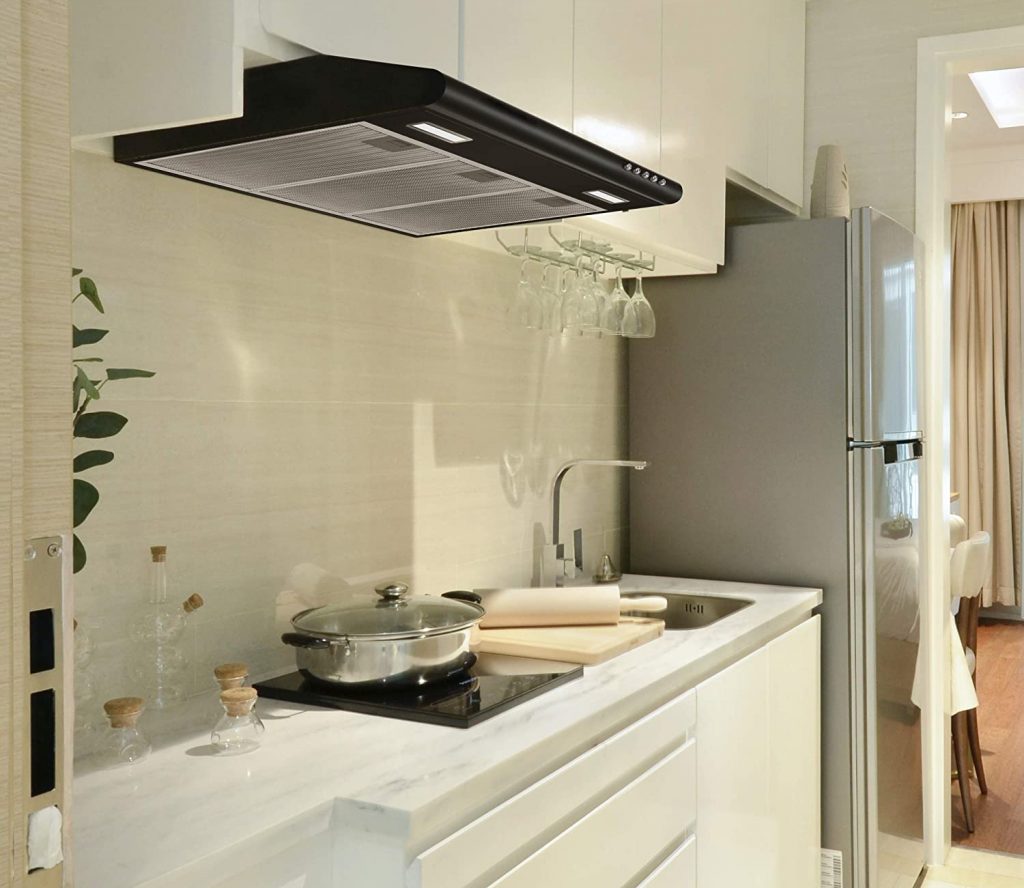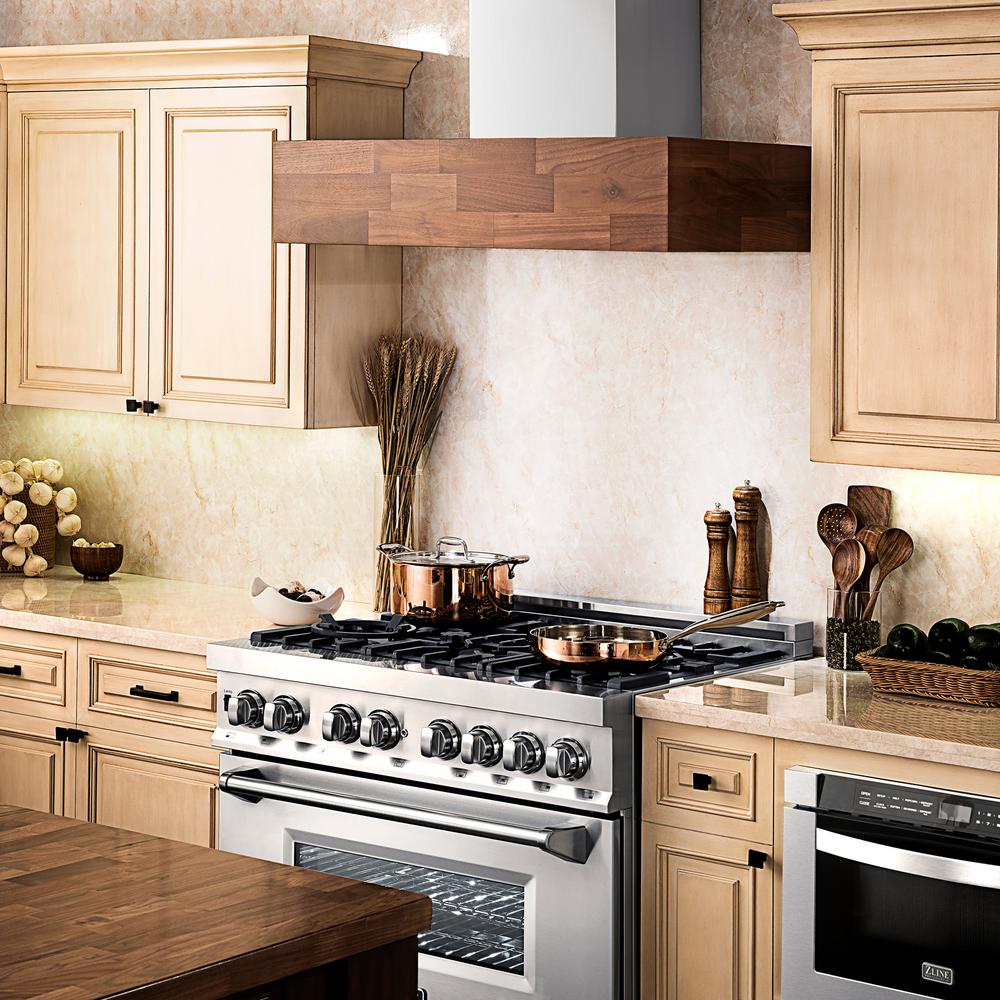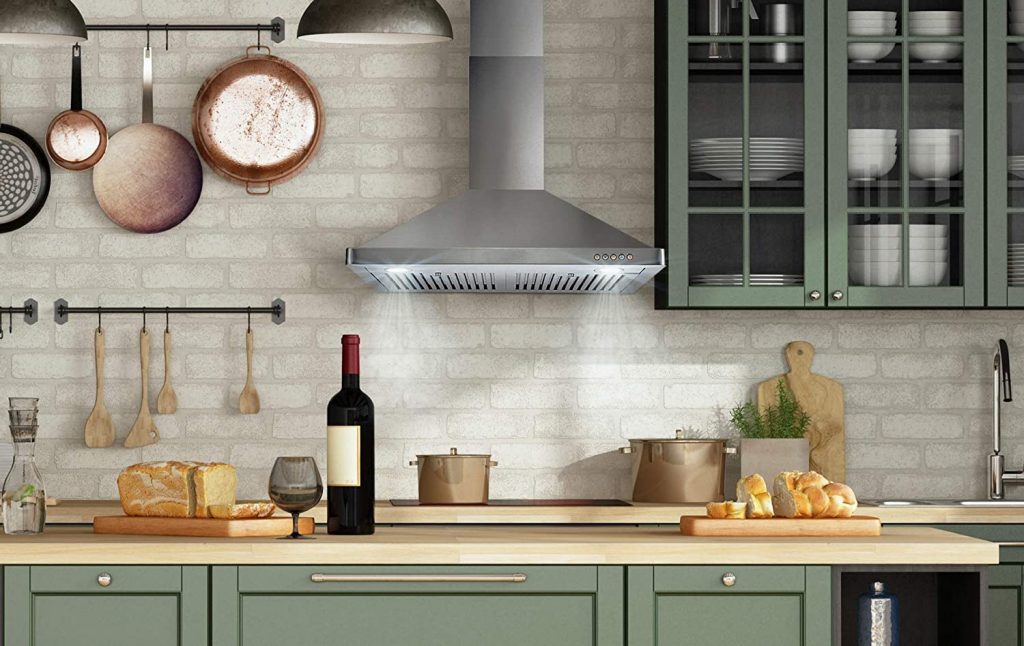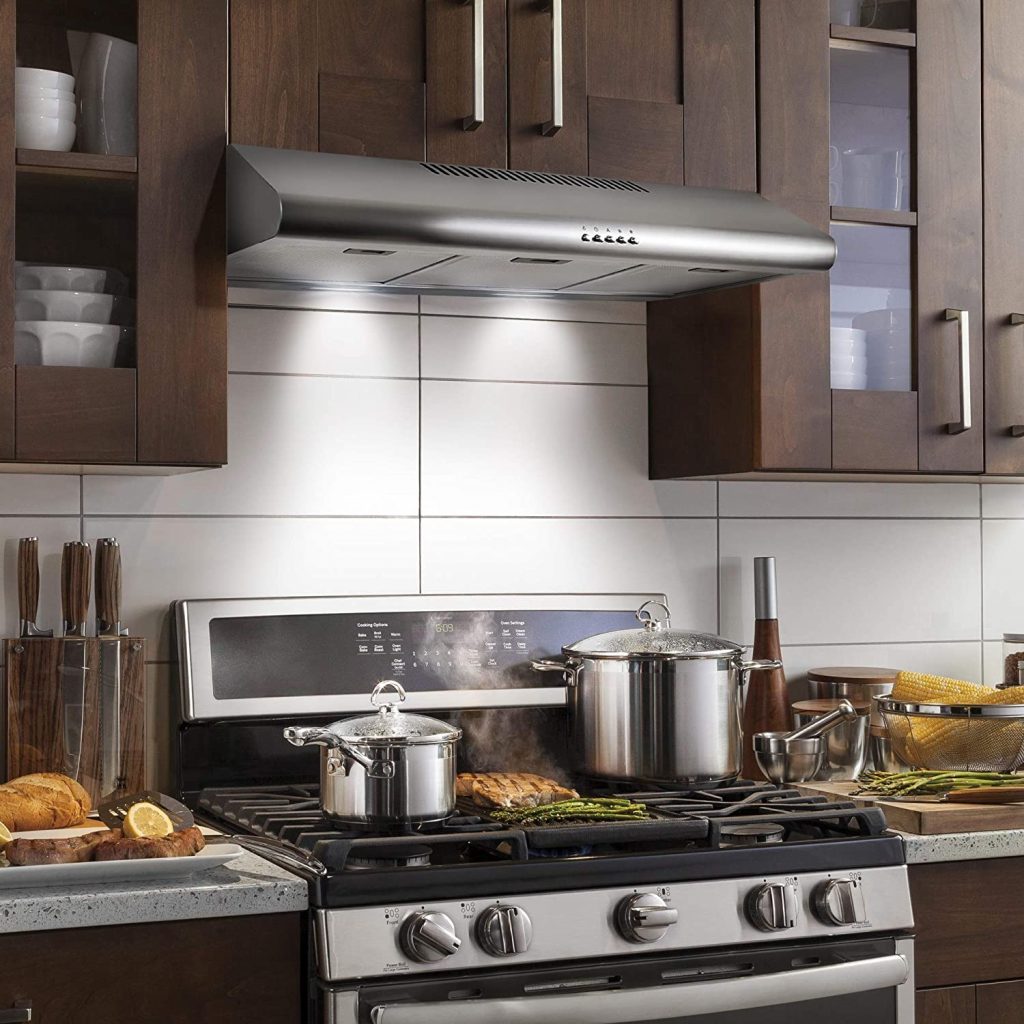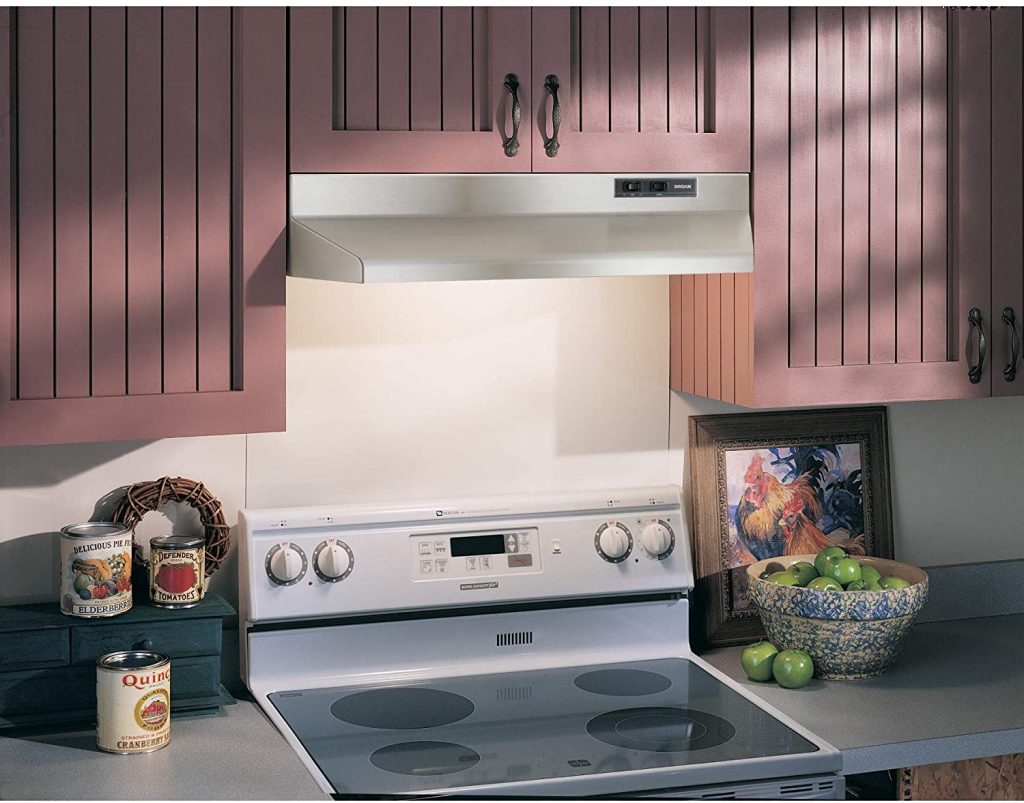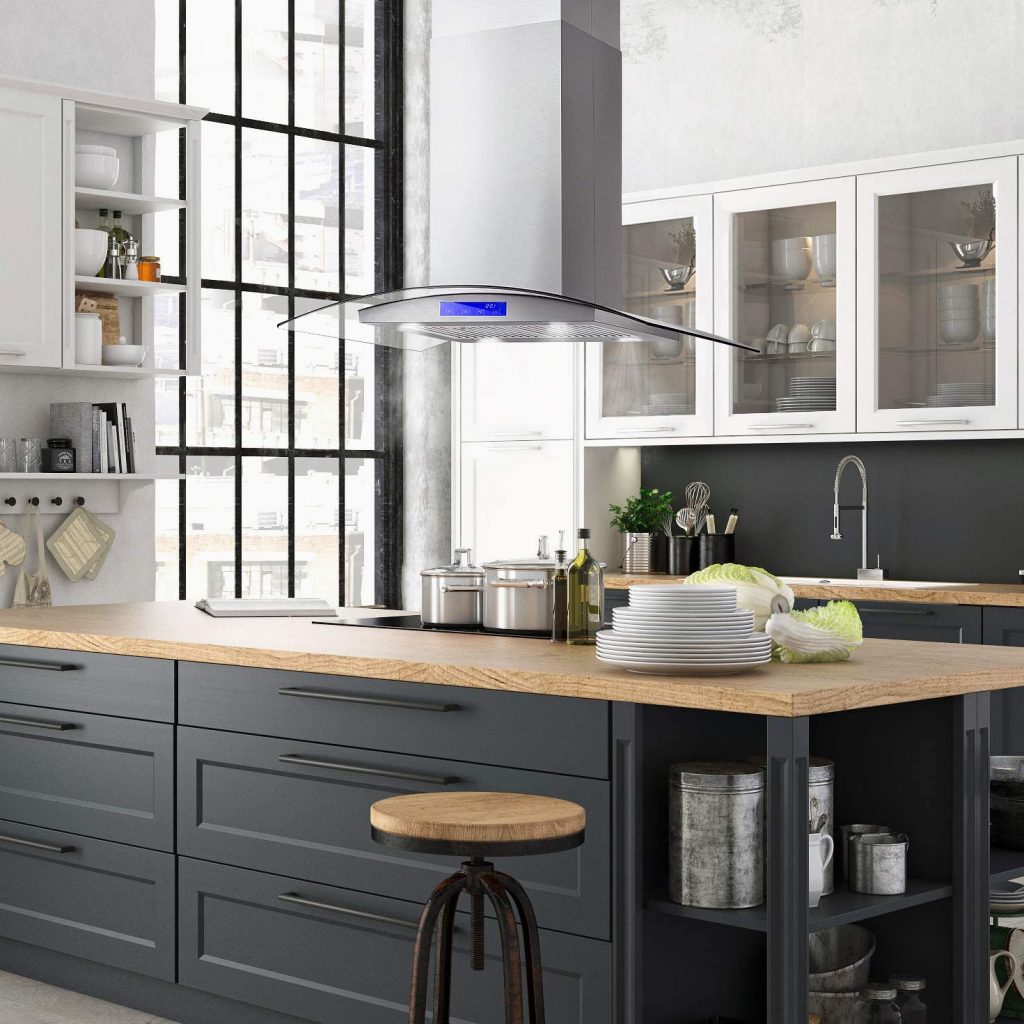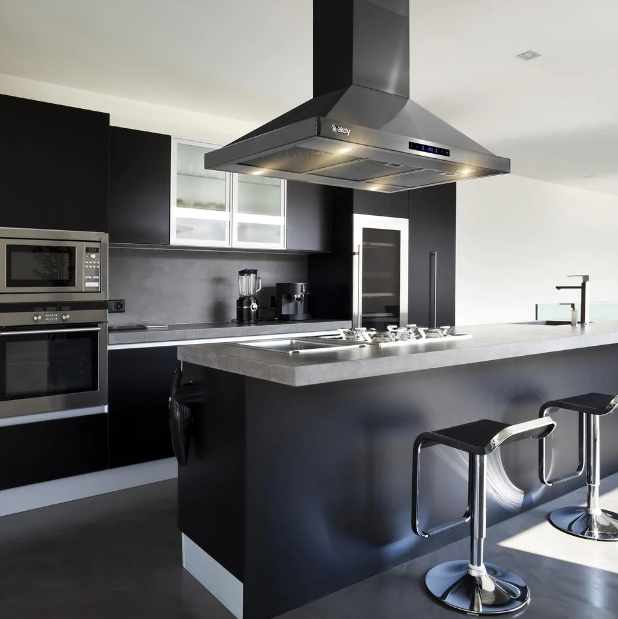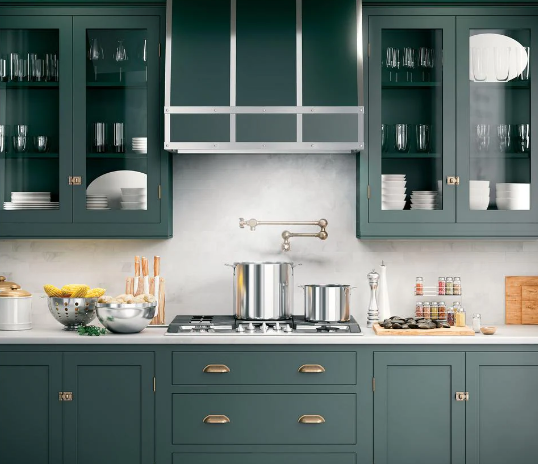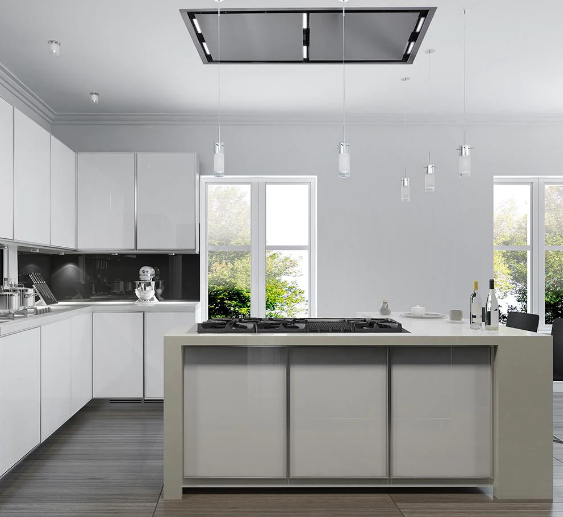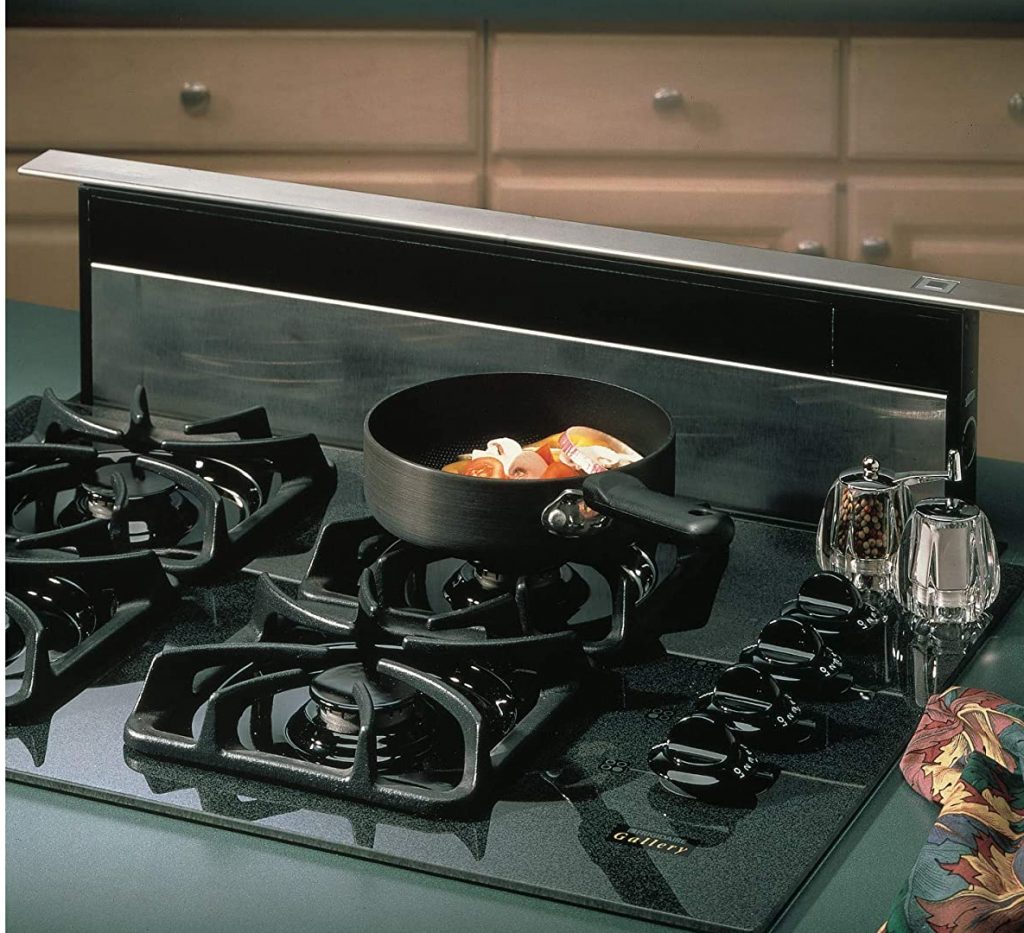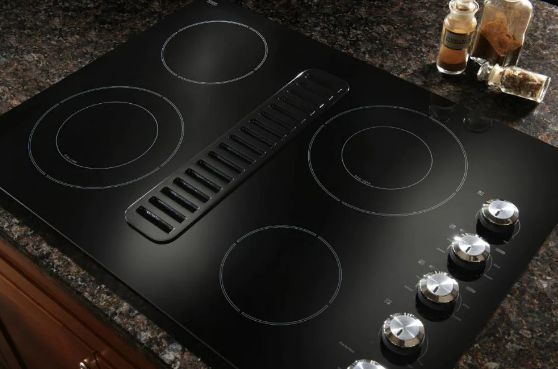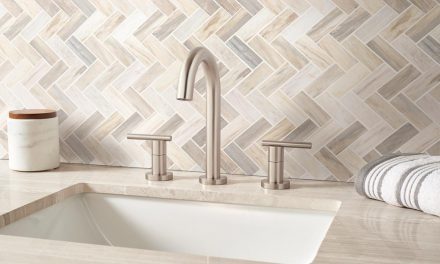No one enjoys working in a kitchen that’s filled with smoke or fumes, especially when that polluted air sets off a smoke detector. Range hoods, which are designed to be mounted above a cooktop range, aim to suck up dirty air, filter it, and (preferably) jettison it from your home. With a range hood, your kitchen becomes a lot more hospitable and healthy place to be.
There’s a lot of misinformation out there about range hoods, some of it pushed by sellers or manufacturers. We’re here to set the record straight. In this article, we’ll cover the basics about range hood sizes and styles, as well as go over how different range hood mounting styles affect aesthetics, cost, and effectiveness. We’ll also help you figure out what to look for in a range hood, from ducting to CFM ratings and more.
Table of Contents
Types of range hood sizes and styles
Range hoods are manufactured in a variety of widths. They can measure 20 inches or fewer, or be as wide as 60 inches for expansive venting. The most common widths available on the market are 30-inch and 36-inch range hoods, respectively, which is no surprise, as these are also the most common widths for standard ovens and cooktops.
You should always choose a range hood that is at least as wide as your cooktop. For even better ventilation and to achieve certain aesthetics, you might choose one that’s even a little bit wider than your cooktop.
Don’t forget height, either. First, you consider the amount of space you want to take up above your cooktop, whether you’re wanting your range hood to extend all the way to the ceiling or not. You should also consider how high above your cooktop you need to install your range hood. Manufacturers will have specific recommendations for this, usually between 30 and 36 inches above the cooktop.
As for materials, the vast majority of range hoods employ stainless steel, and with good reason: it’s safer. Even range hoods that don’t look like stainless steel are often just stainless steel that’s been painted or finished to look like something else.
One of the few exceptions to this is with wooden range hoods, which are still stainless steel at their core, but have a butcher-block-style wood accent or are fully encased in a wood frame. For the most part, only the ZLINE brand produces this style of range hood, along with many other designer range hoods.
What are chimney and canopy range hoods?
You’ll sometimes see the words “chimney” or “canopy” used to describe either wall-mounted or island-mounted range hoods with long necks for ducting. The terms can apply to flat-shaped hoods or rounded/arched hoods.
So what exactly are canopy range hoods and chimney range hoods? The reason these terms can apply to so many different things is they are actually marketing terms with no set definition or appearance. Feel free to ignore them.
What is a “professional” or “commercial style” range hood?
Though the words “professional” and “commercial style” might conjure up images of industrial kitchens, don’t be fooled, these range hoods are made for residential use. The only differences between them and standard range hoods are (sometimes) the quality or thickness of materials. To a great degree, these are simply marketing terms.
Types of range hood mounting
The way you mount your range hood is dictated by the layout of your kitchen and the space you have available. There are several ways to mount a range hood, but given modern trends, you’ll most likely be wall-mounting, installing the range hood under a cabinet, or mounting above an island.
Wall-mounted range hoods
By far, wall-mounted range hoods are the most common style of range hood on the market today. Installed above your cooktop, these range hoods are mounted to the wall, as the name implies. Like island-mounted hoods, many wall-mounted hoods feature long necks where ducting can be neatly hidden.
While wall-mounted range hoods can measure as wide as 60 inches, the vast majority are manufactured in 30-inch and 36-inch configurations to fit standard cooktop widths. Also relatively common is the 48-inch configuration.
Most are ducted, and many are convertible. In general they carry a style that is reminiscent of island-mounted range hoods, with the majority being good old stainless steel. If you want some other finish, you’ll have to hunt for it, though, again, the ZLINE brand does offer quite a few wood-accented range hoods.
These range hoods don’t have to break the bank. They’re available at every price point, from as low as $300, to as high as $2,000.
Under-cabinet range hoods
Like most range hoods, under-cabinet range hoods favor 30-inch and 36-inch designs. However, you’re really most likely to find 30-inch configurations. Most are ducted, though it is relatively easy to find convertible configurations, too.
These are a classic style of range hood, and their appearance tends to reflect that. While the vast majority of under-cabinet range hoods are today manufactured in stainless steel, quite a few are also finished white.
Under-cabinet range hoods trend cheaper than other styles. You can easily find them for less than $500. This affordability is somewhat reflected in their power, as under-cabinet range hoods tend to have lower CFM ratings than their wall-mounted or island-mounted cousins.
Island mounting (ceiling mounting, soffit)
Though mounted to the ceiling, these range hoods are more commonly referred to as island-mounted range hoods instead of ceiling-mounted, simply because this is where you’re going to find them: above a kitchen island. You might also see “soffiting” mentioned in conjunction with these range hoods. “Soffit” is merely an architectural term for the underside of certain materials, including ceilings, where these range hoods are mounted.
While nearly all island-mounted range hoods are convertible, this is a type of range hood you’re definitely going to want to duct. Without a wall to block off one side, island ranges are more open, and the draftiness over and around them requires good ventilation.
For this reason, you’ll often see island-mounted range hoods sold at higher CFM ratings of 400+, with many reaching 800 CFM or higher. They also trend a little larger to better ventilate. Most are designed to be 36 inches wide, though both 30-inch and 48-inch designs remain common, as well.
You’ll generally find island-mounted range hoods are stainless steel, though you can find some finished in black or made to look like other metals, such as copper and bronze.
If you have an island range, expect to pay a pretty penny for a good range hood. Good island-mounted range hoods are more expensive than similarly-powerful range hoods in other styles. While you can find them for under $800, you’re just as likely to spend more than that or even well over $1,000 for a good one.
Insert range hoods (built-in range hoods)
Another sleek, modern look is the inserted range hood, which is also sometimes referred to as a built-in range hood. Whereas island-mounted range hoods put everything on display, insert range hoods are understated. Generally sold in 28-46-inch configurations, insert range hoods tuck beneath cabinets like under-cabinet range hoods or even get inserted into ceilings.
The difference between insert and under-cabinet range hoods is that inserts tend only to show their underside. Their main body is hidden in a cabinet, box, or a conical, chimney-like frame above the stovetop. Under-cabinets show their underside and a canopy-like hood or face.
If you’re a little confused by what counts as an insert, it’s understandable. Some sellers have begun to conflate the terms, selling “insert under-cabinet” range hoods. Technically and aesthetically, though, there is a difference.
A major thing to note about insert range hoods is that nearly all of them require ducting. Only a few are convertible at all. They also tend to be more powerful range hoods to accommodate the fact that they may be installed well above the cooktop, even as high as the ceiling.
Through Home Depot, you’ll find many of these range hoods priced well under $800, and about just as many that cost more than $800.
Downdraft range hoods
When it comes to downdraft range hoods, it’s hardly right to call them “hoods” at all. It’s more accurate to think of them as a pop-up ventilation, as they are installed right behind your range and are only lifted during cooking. Otherwise, they stay flush with your cooktop surface and counter.
Visually, downdraft range hoods are some of the sleekest and most compact kitchen ventilation options available, but they’re not very common, largely because they’re not as effective at venting as a range hood that goes over your range. What is available tends only to appear in standard oven design widths—that is, 30-inch and 36-inch configurations.
These are considerable downsides, given downdraft range hoods tend also to be some of the most expensive, with nearly all costing well above $1,000.
Don’t have an oven or range yet to know if this style of range hood is right for you? In that case, don’t overlook the fact that there are actually ranges that have ventilation built right into their cooktop surface, as well. They’re called downdraft cooktops, and both KitchenAid and GE produce several models with this built-in ventilation.
Over-the-range microwaves
When you go to buy this type of range hood, you’re actually buying a microwave that has built-in venting mechanisms. Over-the-range microwaves are what they sound like: they’re microwaves taken away from the countertop and placed above the range.
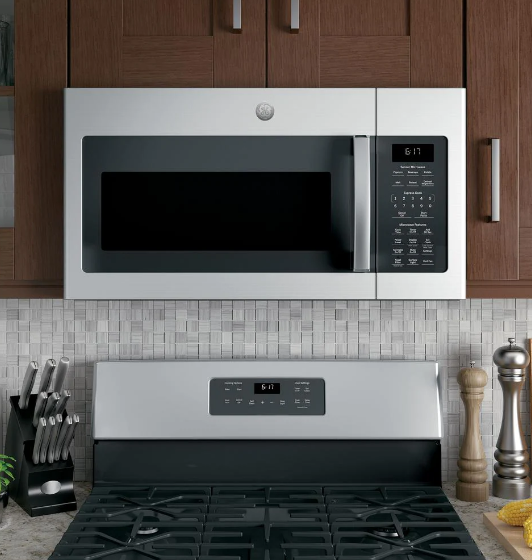
See GE’s 1.7 cubic-foot over-the-range microwave, which is 30 inches wide.
While an affordable ($200-$600) and convenient space saver, over-the-range microwaves have weak venting capabilities that may not be appropriate for every kitchen. (That said, many have 400 CFM ratings, which may be just fine, depending on your kitchen and use of it.) Moreover, though many have convertible venting, recirculation of air is also relatively common. This is far less effective and will leave fumes behind.
In general over-the-range microwaves work best in apartments and other compact housing. If you have the space for it otherwise, go with a proper range hood. Even the most expensive over-the-range microwaves can’t hope to achieve the ventilation that affordable range hoods can.
What to look for in a range hood
Though it may be tempting to choose a range hood simply according to its style or price, you really need to understand some basic terms and concepts before you go shopping.
Ducted range hoods vs. recirculating range hoods
Choosing between ducted and ductless (recirculating) range hood options is the biggest practical decision you’ll face when buying a range hood. Fortunately, there’s a clear winner here in terms of maintaining and improving air quality, and it’s ducted range hoods.
Ducted range hoods
Ducted range hoods vent to the outside of your home, doing a good job of removing steam, smoke, and food odors entirely. More powerful range hoods—typically those with more than 400 CFM—make use of a second line of ductwork that draws air from the outside, thereby replacing polluted air with fresh air (this is called make-up air). You can see one of these dual-ducted range hoods in action in the video below.
Because of their great ability to ventilate, ducted range hoods help prevent grease from building up around your kitchen, saving you from having to clean and repaint so often. The clean air is better for your health
Unless your range and its hood is placed on a wall in your kitchen that also faces the outside, you’ll need to duct a ducted range hood through a wall or ceiling (and roof) using additional HVAC ducting.
While ducted range hoods are better than ductless ones, not all ductwork is created equal. If you have narrow ductwork, very long ductwork, or many curves in your ductwork, it won’t clear out nasty air as fast as wide, straight ductwork that quickly opens to the outside. For these reasons, don’t be surprised if you need to hire a professional for this type of range hood.
Ductless range hoods (duct-free range hoods, recirculating range hoods)
Do range hoods have to be vented outside? No, but as stated above there are good reasons to vent outdoors. Still, ductless range hoods do have their own advantage: they’re much simpler to install precisely because there’s no ducting, and therefore no venting, involved.
These range hoods simply recirculate air through mesh and carbon filters. The filters catch smoke and odor-causing particles, attempting to clean the air before it is pushed back into the kitchen.
Because of their filters, ductless range hoods can fool your nose into thinking your air is clean when it’s not. (Your smoke detector may know what’s up, though!) A ductless range hood is better than no range hood at all—breathing in the unfiltered smoke generated from cooking isn’t healthy—but it can never offer you the same quality as a ducted range hood.
Convertible range hoods
These days, most range hoods are convertible, meaning they come in both ducted and ductless configurations. So if you’re wondering what the difference is between ducted and convertible range hoods, it’s really a matter of how you use a convertible range hood. It’s up to you!
Again, if you have the option, ducting your ventilation will always give you better results, while also being quieter and healthier.
CFM (cubic feet per minute)
CFM, which stands for cubic feet per minute, is the amount of air in a space (cubic feet) that a vent is able to clear each minute a range hood (or any other device that manages airflow) is in use. In other words, CFM is a measurement of airflow through a fan system.
When it comes to what’s available on the market, it’s easy to find range hoods rated from 400 to 1200 CFM. While there’s no strong correlation between CFM rating and range hood size, there is some between type of range hood. Over-the-range microwaves and ductless range hoods tend to have the lowest CFM ratings, while wall-mounted and island-mounted range hoods have higher CFM ratings in general.
But what does any of this mean?
Well, the larger the CFM number, the more air a manufacturer is claiming that range hood moves—and therefore clears—each minute. So, if a range hood is rated to be 400 CFM, they’re claiming it can vent or clear the air of 400 cubic feet of space (about 50 square feet) every minute.
But airflow isn’t everything. (As you saw above, ductwork in general is what’s really important.) Lots of sellers will try to upsell you on CFM and burden you with complicated calculations, when really the CFM you need often simply comes down to the space you’re trying to keep clear of smoke and fumes. Sure, you can get a 1000 CFM range hood for a tiny kitchen, but you probably don’t need it.
Sellers and sites that recommend you calculate the CFM you need by the size of your range hood are often basing their calculations off of commercial needs, not residential ones, and they’re downplaying the importance of your ductwork.
Still, if you want a rule of thumb, you can use the Home Ventilation Institute’s recommendations, which are 100 CFM for every linear foot of your range if your range is placed against a wall. So if your range is 30 inches wide, or 2.5 feet wide, 250 CFM may adequately ventilate the smoke and fumes your range produces. They recommend slightly higher CFM (150 CFM per linear foot of range) for island-mounted range hoods.
Do gas ranges need a higher CFM rating?
Common claims that gas cooktops or certain styles of cooking, like Chinese cuisine, generate more smoke and fumes, and therefore need more powerful ventilation, can be a little misleading. A lot really depends on how you personally use your cooktop, regardless of whether it’s gas or electric. If you like cooking with certain oils or fats at high temperatures that generate lots of smoke, buy a range hood that has a higher CFM rating than your space requires by default.
Gas cooktops also come with the added concern of carbon monoxide output. Unless your gas cooktop or gas connection has problems, it should put out little to no carbon monoxide. However, it’s not uncommon for gas ranges to output unsafe levels of carbon monoxide. So you may indeed want better ventilation with make-up air if you have a gas range, but more than anything this is something you should watch for in your gas cooktop, regardless of your range hood.
Know what makes for a safe gas flame! Blue flames indicate the gas is being burned off, while yellow flames indicate the gas isn’t being burned off and is instead remaining in the air.
If your range’s gas flame isn’t nearly always blue, it’s putting out a lot of carbon monoxide, and you should stop using it immediately. If it doesn’t have the classic blue, two-coned shape of a properly combusted gas flame, it is also putting out carbon monoxide, though not as large an amount.
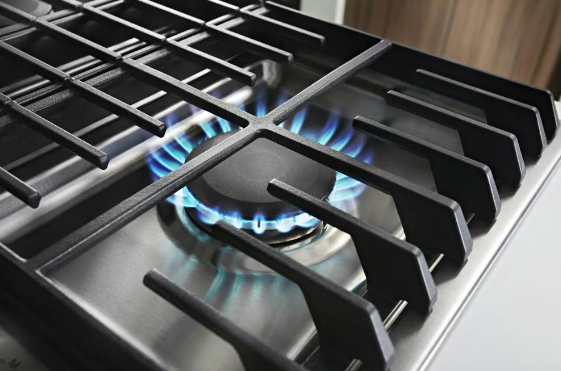
This is an example of a safe gas flame, as seen on KitchenAid’s 30-inch downdraft gas cooktop.
Local building codes affect CFM requirements
There are state and/or local rules on range hoods. They often dictate the minimum ventilation required in a home, as well as the materials one must use for ductwork. There are different requirements for residences versus commercial spaces.
When it comes to these laws, you generally don’t have to be concerned that you’re buying anything too weak for them. Instead, you need to make sure your range hood isn’t so powerful that there aren’t special requirements for it. For example, some local building codes require dual ductwork for make-up airflow when your range hood exceeds 400 CFM.
Noise levels (sones)
A range hood can do a great job of keeping the air in your kitchen clean, but sometimes it’s at the expense of your ears. Some range hoods make a lot of noise, especially on their more powerful settings.
If you’re sensitive to loud sounds, you’re going to want to pay attention to sones. Sones measure perceived loudness, so they’re an imperfect kind of measurement, but there is science behind them.
The lower the sone rating, the quieter the range hood. The higher the sone rating, the more noise you can expect from it.
Most range hoods are fairly loud, receiving a vague sone rating of “4+”. If you want a quieter range hood, you’ll need to hunt for one. That said, wall-mounted range hoods often trend quieter than island-mounted and under-cabinet range hoods. Similarly, range hoods with higher CFM ratings also tend to be louder, but a lot depends on construction.
Nice-to-have features
There are many other features available on range hoods, but they come down to personal preference. Small, but nice-to-have features you might be on the lookout for are things like touch controls, lighting options, self-cleaning modes, exhaust timers with automatic shut-offs, and sensors that will adjust fan speeds according to what they detect your cooking is requiring in the moment.
Are range hoods worth it?
If you don’t cook often, a range hood may not be worth it for your kitchen, especially if you have a larger, open kitchen, where airflow isn’t so hampered by tight spacing and nearby walls. But if you do cook at least some each week, it’s not a bad idea to install a range hood. Just remember, a range hood is most valuable if you can vent it to the outside.
Range hoods are especially useful for those who cook frequently and those who like cooking foods at high temperatures. They also provide added protection against carbon monoxide fumes. While your gas range’s flames should be safe, in the event that they become less so over time, a range hood will go a long way to clearing your air of dangerous fumes. This doesn’t mean you shouldn’t fix any problems with your gas range, though, because you absolutely should.
DIY range hood installation
How easy is it to install a range hood? Well, that depends on the range hood you buy, where it needs to be installed in your kitchen (whether against a wall or in the ceiling), and how you’re venting it. If you already have established ductwork, installing a new range hood may not be too complicated. But if you’re working with ductwork from scratch, you probably want a professional.
Check out the video below to see how professionals vent a wall-mounted range hood through a house wall.


